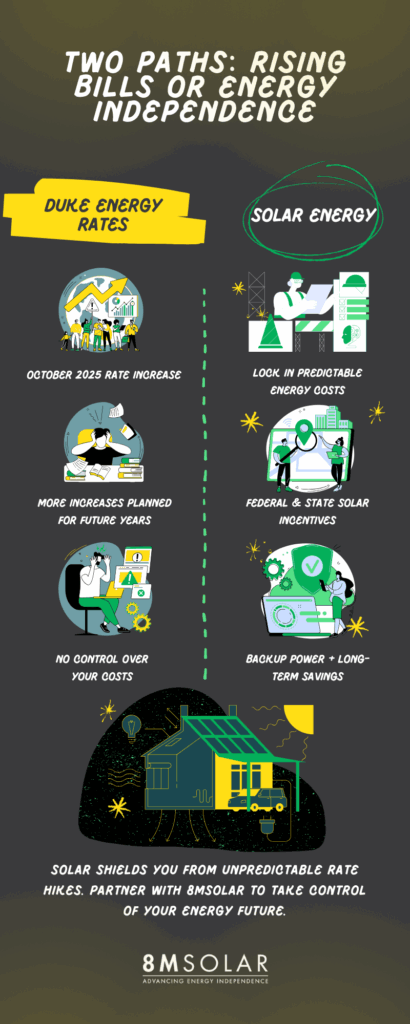North Carolina residents will see their electricity bills increase starting October 2025, as Duke Energy implements a rate adjustment across the state. This change comes at a time when many households are already grappling with rising costs of living, making the timing challenging for homeowners and businesses alike.
The rate increase is part of Duke Energy’s plan to modernize North Carolina’s electrical infrastructure while transitioning toward cleaner energy sources. Understanding why these increases are happening can help you make informed decisions about your energy future and explore alternatives that might help offset rising electricity costs.
Table of Contents
- The Foundation of Duke Energy’s Rate Increase Strategy
- Grid Upgrades and Infrastructure Modernization
- Meeting North Carolina’s Growing Energy Demand
- Transition to Cleaner Energy Sources
- Reliability and Performance Standards
- Multi-Year Investment Strategy
- Supporting Vulnerable Customers
- Is Solar Still Worth It Without the Federal Tax Credit?
- Making Informed Energy Decisions
The Foundation of Duke Energy’s Rate Increase Strategy
Duke Energy’s October 2025 rate increase stems from a multi-billion dollar investment strategy designed to transform North Carolina’s energy landscape. The utility company is pursuing an ambitious modernization plan that touches every aspect of the electrical grid, from generation facilities to the lines that deliver power to your home.
At its core, this rate increase reflects the capital requirements needed to upgrade aging infrastructure while building new renewable energy capacity. Duke Energy has committed to investments in solar and wind projects, grid hardening initiatives, and advanced technologies that will improve service reliability for customers across the state.
The timing of these increases also aligns with North Carolina’s growing energy demands. As the state’s population continues to expand and economic development accelerates, the existing electrical infrastructure faces unprecedented pressure. Duke Energy’s rate adjustments help fund the capacity expansions necessary to meet this growing demand without compromising service quality.
Grid Upgrades and Infrastructure Modernization
One of the main drivers behind Duke Energy’s rate increase is the urgent need for grid upgrades and modernization. North Carolina’s electrical infrastructure includes equipment and transmission lines that are decades old, some dating back to the mid-20th century. These aging systems are more vulnerable to severe weather events and struggle to meet modern reliability standards.
Duke Energy is investing in grid hardening initiatives designed to reduce the duration and frequency of power outages. This includes replacing wooden utility poles with more durable materials, upgrading transformers and switching equipment, and installing advanced monitoring systems that can detect and isolate problems before they affect large numbers of customers.
The modernization efforts also include implementing smart grid technologies that allow for better energy management and faster restoration of service after outages. These systems use real-time data to optimize power flow, automatically reroute electricity around damaged equipment, and provide customers with more detailed information about their energy usage.
Underground power lines are another component of Duke Energy’s infrastructure investment strategy. While underground installation costs more than traditional overhead lines, these systems offer protection against storm damage and reduce the visual impact of electrical infrastructure in residential areas.
Meeting North Carolina’s Growing Energy Demand
North Carolina’s strong economic growth and population expansion have created unprecedented demands on the state’s electrical infrastructure. The Research Triangle, Charlotte metropolitan area, and other economic centers are experiencing rapid development that requires big increases in electrical capacity.
New residential developments, expanded manufacturing facilities, and the growth of data centers all contribute to rising energy consumption across the state. Duke Energy must build additional generation capacity and expand transmission networks to ensure reliable power delivery to these growing communities.
The challenge becomes more complex when considering peak demand periods. Air conditioning loads during hot summer months and heating demands during winter create stress on the electrical system. Duke Energy’s infrastructure investments help guarantee the grid can handle these peak loads without experiencing brownouts or blackouts.
Industrial customers also drive substantial energy demand growth. North Carolina’s manufacturing sector, including textile production, furniture manufacturing, and emerging technology companies, requires reliable, high-quality electrical service to maintain operations.

Transition to Cleaner Energy Sources
Duke Energy’s rate increase directly supports the company’s transition toward renewable energy sources, particularly solar and wind power. This transition is one of the largest infrastructure transformations in North Carolina’s history, requiring massive investments in new generation facilities and supporting infrastructure.
Solar energy development is a large portion of Duke Energy’s renewable energy investments. The company is building large-scale solar farms across North Carolina while supporting distributed solar programs that allow homeowners and businesses to generate their own energy.
Wind energy projects, particularly offshore wind developments along North Carolina’s coast, require substantial upfront investments in turbines, transmission infrastructure, and maintenance facilities. These projects promise to deliver clean energy for decades but require capital commitments that contribute to current rate increases.
The transition away from older fossil fuel plants also creates costs that must be recovered through rates. Decommissioning coal plants, environmental remediation, and replacing that generation capacity with cleaner alternatives all incur expenses that Duke Energy has to finance through customer rates.
Energy storage systems, including large-scale battery installations, are becoming more important as renewable energy sources provide a larger percentage of the state’s electricity. These storage systems help manage the intermittent nature of solar and wind power while providing grid stability services.
Reliability and Performance Standards
Duke Energy’s rate increase includes investments designed to improve service reliability and meet increasingly stringent performance standards. North Carolina regulators have established clear expectations for utility performance, including metrics for outage frequency, restoration times, and customer satisfaction.
The company is implementing performance incentive mechanisms that tie rate recovery to actual reliability improvements. This means Duke Energy must demonstrate measurable improvements in service quality to justify portions of their rate increases, creating accountability for the investments being made.
Advanced weather monitoring and prediction systems help Duke Energy prepare for severe weather events before they impact the electrical grid. These systems enable proactive measures like pre-positioning repair crews and shutting down equipment safely before dangerous conditions arrive.
Vegetation management programs are another significant reliability investment. Regular tree trimming and removal near power lines reduces the risk of outages caused by falling branches or trees, especially during severe weather events.
Multi-Year Investment Strategy
The October 2025 rate increase is just one phase of Duke Energy’s multi-year investment strategy. This long-term approach allows the company to spread major infrastructure costs over several years while maintaining steady progress toward modernization goals.
Future rate adjustments will continue as Duke Energy completes additional phases of their infrastructure improvement plan. However, the multi-year approach provides more predictability for customers and allows for better planning of major capital projects.
The company’s long-term strategy also includes provisions for adjusting investment priorities based on changing conditions, technological advances, and regulatory requirements. This flexibility helps make sure that customer money is spent on the most effective and necessary improvements.
Supporting Vulnerable Customers
Duke Energy’s approved rate plans include important provisions for supporting low-income customers and vulnerable residents who may struggle with higher electricity costs. These programs recognize that rate increases can create financial hardship for some customers while providing necessary infrastructure improvements.
Financial assistance programs help eligible customers manage their electricity bills through direct payment assistance, weatherization programs, and energy efficiency initiatives. These programs aim to reduce the impact of rate increases on households that can least afford higher energy costs.
Energy efficiency programs funded through the rate increase help all customers reduce their electricity consumption, potentially offsetting some of the impact of higher rates. These programs include rebates for efficient appliances, home weatherization services, and educational resources about energy conservation.

Is Solar Still Worth It Without the Federal Tax Credit?
Many homeowners wonder whether solar energy will remain a smart investment once the federal solar tax credit phases out. The answer is a resounding yes, in light of Duke Energy’s rate increases and the broader trend of rising electricity costs across North Carolina.
The federal Solar Investment Tax Credit currently provides savings on solar installations, reducing the upfront cost by 30%. While this incentive makes solar more affordable today, the economics of solar energy don’t depend solely on tax credits. The real value comes from protection against rising electricity rates.
Duke Energy’s October 2025 rate increase won’t be the last. Utility companies across the country continue raising rates to fund infrastructure improvements, renewable energy investments, and grid modernization efforts. These increases typically occur every few years, creating a steady upward trend in electricity costs that shows no signs of slowing.
When you install solar panels, you’re locking in a large portion of your electricity costs for the next 25 to 30 years. While your solar system does involve an upfront investment, it provides predictable energy costs that protect you from future rate increases. The higher electricity rates climb, the more valuable your solar investment becomes.
If Duke Energy raises rates by just 3% annually over the next 20 years, homeowners without solar will pay nearly 81% more for electricity by 2045. Solar panel owners will continue generating electricity at the same cost they paid upfront, making their savings compound over time.
The mathematics become more compelling when you factor in Duke Energy’s multi-year rate increase strategy. With additional rate adjustments likely in the coming years, the payback period for solar installations shortens. Many homeowners are finding that solar systems pay for themselves in 7 to 10 years, even without considering federal incentives.
Battery storage systems enhance the value proposition by allowing homeowners to store solar energy for use during peak rate periods or during power outages. As Duke Energy implements time-of-use rates in the future, battery storage becomes an even more valuable tool for managing electricity costs.
State and local incentives also continue to support solar adoption in North Carolina. Net metering policies allow solar customers to receive credit for excess energy they send back to the grid, improving the economics of solar installations.
Making Informed Energy Decisions
Duke Energy’s October 2025 rate increase reflects the reality of modernizing North Carolina’s electrical infrastructure while transitioning to cleaner energy sources. While these investments are necessary for long-term grid reliability and environmental goals, they do create cost pressures for customers.
Understanding the reasons behind these rate increases can help you make informed decisions about your household’s energy future. Whether you choose to implement energy efficiency measures, explore solar energy options, or simply budget for higher electricity costs, knowledge about these changes empowers better decision-making.
At 8MSolar, we’re committed to helping North Carolina families and businesses explore clean energy solutions that provide long-term value and energy independence. Our solar installations help customers reduce their reliance on grid electricity while contributing to the state’s clean energy goals.
If you’re interested in learning how solar energy might help offset rising electricity costs and provide greater energy security for your home, contact 8MSolar today. Our experienced team can assess your property’s solar potential and design a system that meets your energy needs and budget. Take control of your energy future and join the growing number of North Carolina residents who are choosing solar energy for reliable, clean, and affordable power.

